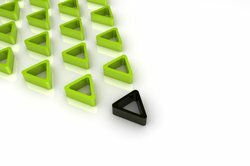Triangle: Derivation with vectors
You have seen through the usual vector calculation, but how you are to determine the center of gravity of a triangle through the vectors is a mystery to you. So what do you need to know about the derivation and how do you go about it?

This is the center of gravity of a triangle
- To draw the centroid of a given triangle, first note that the centroid of each triangle is the intersection of its three bisectors.
- So you draw the bisectors in a triangle. To do this, draw a straight line from each triangle corner point, which finally meets the center of the opposite side of the triangle. If you have drawn the bisector from all three corner points, they will meet within the triangle. You can mark the point at which they meet as a corner point.
- Also the points in which the Straight lines meet the side lines of the triangle, you must mark and name them. If necessary, these can be denoted by the letters d, e and f.
Derivation of the center of gravity via vectors
- In order to derive a triangular centroid using vectors, you first need the knowledge that Vector AB plus vector BF result in vector AF, with vector AF being the one of the side bisectors drawn previously is. Since you do not know F, you must first replace AF with quantities you are familiar with.
- According to the formula collection, the bisectors of a triangle always intersect in a ratio of 2: 1. You are now bringing this thought together with the above. You will find that the vector of the side bisector AF is 2/3 of the center of gravity vector AS.
- This results in the calculation AB plus BF = 2/3 AS for you. To solve this calculation and to get the vector of point A and center of gravity, only BF has to be replaced by known quantities.
- It is important to remember that the bisector divides the respective page exactly in the middle. This gives the ratio BF = 1/2 BC. Since B and C are known to you, BF can now be replaced by 1 / 2BC so that the calculation of the center of gravity can finally be solved using known vectors.
- You will now receive the invoice AB + 1 / 2BC = 2/3 AS. Insert the vector coordinates of AB and BC and calculate the x and y coordinates for S, and the vectorial derivation of the triangle's center of gravity is done.
Halve the triangle - this is how it's done
Halving any triangle is definitely a trick behind it. In …
How helpful do you find this article?


